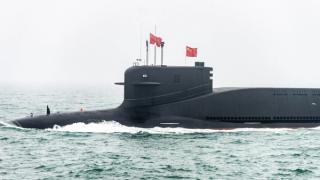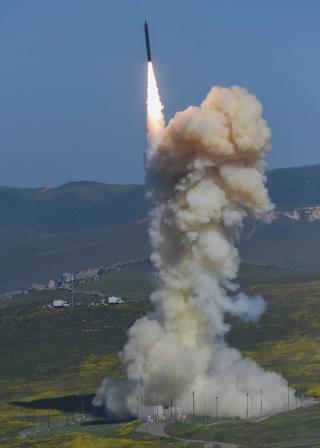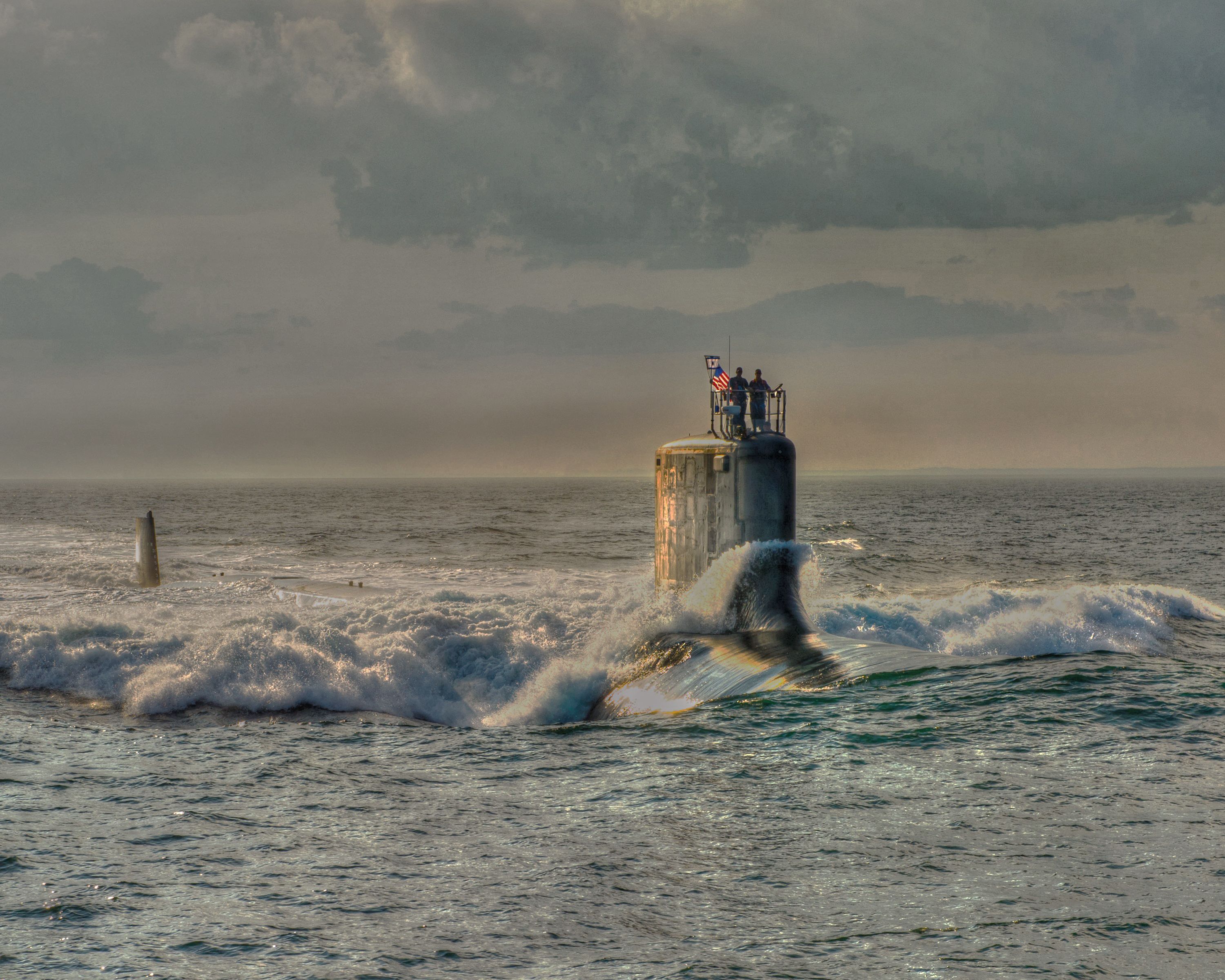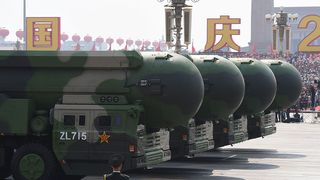Key takeaways
- There is a small risk of deliberate nuclear use and a larger risk of inadvertent nuclear use in a future US-China conflict, both of which could increase if the possibility of conflict grows or if Washington or Beijing pursue more ambitious nuclear strategies.
- China’s nuclear strategy has to date focused on deterring an adversary’s nuclear threats and use. While its recent nuclear arsenal modernisation is consistent with this strategy, Beijing has acquired new capabilities that could enable a shift to a nuclear first-use strategy.
- The United States and China are not in a nuclear arms race. Nevertheless, efforts by the United States to maintain its current margin of superiority over China’s nuclear forces, or to deter North Korea or Russia, could prompt further growth in China’s arsenal.
- Australia’s interests would be best served by an allied military strategy for countering China that emphasises robust conventional capabilities, relies on US nuclear weapons to deter the unlikely prospect of Chinese nuclear first-use, and strives to mitigate the risks of inadvertent nuclear escalation.
- Australia should work through existing mechanisms for consultation in the alliance, as well as multilateral fora, to lessen the risks of nuclear use in a future US-China conflict scenario and support informal arms control among the five permanent members of the United Nations Security Council.
Introduction
The United States and China are entering into a period of intense strategic competition. Canberra has responded, in part, by increasing its security cooperation with Washington and other powers in an effort to deter Chinese behaviour that is threatening to disrupt regional security. But risks within the US-China nuclear relationship due to this growing rivalry receive less attention than China’s grey zone and conventional military threats in Australia’s national security policy and debates.1 As the prospect of high-intensity military conflict in the Indo-Pacific becomes more likely, Beijing, Washington, and Canberra will need to manage nuclear risks more proactively.
The contemporary US-China dynamic has fewer nuclear risks than the Cold War US-Soviet relationship, but they should not be ignored. There is a low risk of intentional nuclear use and a greater risk of inadvertent nuclear use in a future US-China conflict. One of the key reasons these nuclear risks are relatively moderate is that, until now, China has adopted a more restrained approach to nuclear weapons compared to the United States and the Soviet Union during the Cold War. This restrained approach to nuclear strategy contrasts with China’s extensive conventional military build-up over the past two decades, starkly illustrated by the growth in China’s conventional missiles from a handful to more than a thousand within this period. Today, China’s nuclear arsenal is growing and diversifying in ways that are consistent with continued restraint but also lay the foundations for Beijing to adopt a more offensive nuclear posture in the future if it chose to do so. Further, recent nuclear policy shifts from Washington could reinforce or even create incentives for a change in Beijing’s nuclear posture which would negatively impact regional security.
China’s nuclear arsenal is growing and diversifying in ways that are consistent with continued restraint but also lay the foundations for Beijing to adopt a more offensive nuclear posture in the future if it chose to do so.
Australian policymakers must be attentive to these dangers in the US-China relationship. Some nuclear risks are inevitable if Australia, the United States, and other regional powers field an adequate conventional military capability to deter China from using force in the Indo-Pacific. But an allied military strategy for countering China that relies too heavily on the possibility of nuclear use is less likely to be credible than one based primarily on robust conventional military capabilities. Moreover, nuclear use in a future US-China conflict would be a tragedy on Australia’s doorstep that Canberra should do everything it can to prevent. Australian interests would be best served by a US — and allied — military strategy that does not rely on nuclear risks to deter Chinese conventional military operations but does see a role for nuclear weapons to credibly deter Chinese nuclear use.2 Canberra should use what influence it has through existing channels for US-Australia alliance cooperation and in multilateral fora to mitigate US-China nuclear risks where possible.
An increasingly complex nuclear relationship
China and the United States have possessed nuclear weapons for more than half a century. China tested its first nuclear weapon in 1964 and has slowly developed a small but survivable arsenal of no more than 300 nuclear weapons.3 Its arsenal is largely composed of theatre and intercontinental-range missiles mounted on transport-erector-launcher (TEL) trucks. In a crisis or conflict, those trucks would patrol China’s vast hinterland to evade detection by US satellites and ensure they would survive a US “counterforce” strike to eliminate China’s nuclear weapons. China is also investing in additional nuclear systems. The Pentagon reported China achieved a credible deterrent based on its Type 094 ballistic missile submarines (SSBNs) in 2016.4 US officials predict that China will soon deploy an air-launched ballistic missile.5 While China’s submarine-based deterrent is (and its aircraft would be) less survivable than its land-based missiles,6 Chinese analysts point to its unique advantages for penetrating enemy missile defences, such as those deployed by the United States.7
While China provides much less detail about the goals of its nuclear strategy and how the force operates than the United States, researchers can consult reliable Chinese-language sources for more detailed insights.8 China’s nuclear strategy has two goals: to deter other countries from threatening China with nuclear weapons and to retaliate if China suffers a nuclear attack.9 Its nuclear capabilities, operations, and command and control arrangements reflect an “assured retaliation” posture, which involves “the development of secure second-strike nuclear capabilities that enable a state to threaten certain nuclear retaliation should it suffer primarily a nuclear attack.”10 The first-use of nuclear weapons in a conventional war to gain military or coercive advantages is not a goal of China’s nuclear strategy stated in either official white papers or other reliable documents.11

China’s current small arsenal — which does not contain nonstrategic nuclear weapons and which is kept on low alert — is not ideally structured for Beijing to issue credible threats of nuclear first-use in order to gain leverage in a conventional conflict.12 In other words, China’s nuclear no first-use declaratory policy appears to have a strong influence on how it structures and operates its nuclear forces.13 China’s land-based nuclear warheads and delivery systems are believed to be stored separately in peacetime, in contrast to US or Russian missiles that remain on day-to-day alert. It is not clear how China approaches warhead handling for its SSBNs, or how frequently they conduct deterrent patrols in peacetime. The country’s top political and military leaders tightly control decisions to alert or use China’s nuclear missiles.14 These practices make China’s nuclear forces vulnerable to a disarming strike when they are not alerted.15
China’s nuclear arsenal is becoming more sophisticated and slightly larger, changes that are consistent with its assured retaliation posture but have generated some uncertainty about how it will use its nuclear weapons in the future. This uncertainty sparks concern when viewed through the lens of China’s recent willingness to abandon longstanding principles and restraint in other areas of its foreign and defence policy. In 2019, US Defense Intelligence Agency officials estimated that China’s arsenal could double its current size from the “low hundreds” to “several hundreds.”16 These changes are consistent with China’s assured retaliation posture because its arsenal is sized according to what is necessary to retaliate against an adversary.17 The deployment of US missile defence sensors and interceptors to deal with a growing North Korean nuclear threat have increased those requirements for Beijing.18 A larger number of intercontinental-range missiles and a more diverse set of delivery platforms gives Beijing a wider margin for error against a US disarming first strike and an increasingly sophisticated US missile defence system.
China’s nuclear arsenal is becoming more sophisticated and slightly larger, changes that are consistent with its assured retaliation posture but have generated some uncertainty about how it will use its nuclear weapons in the future.
China’s fielding of new nuclear delivery systems with ranges limited to the Indo-Pacific has created the most speculation that its nuclear posture is changing.19 Those weapons have legitimate applications for both assured retaliation and more offensive, first-use nuclear postures. China’s new theatre-range nuclear missile, the DF-26 with a range of roughly 4000 kilometres, could be used in response to a limited US first nuclear strike, consistent with China’s assured retaliation strategy. Until now China has had few good options for limited retaliation, fielding only a small number of a less accurate, less survivable, shorter theatre-range nuclear missile, the DF-21A. But the DF-26 also gives China better options for limited first-use, notwithstanding the fact that China has reaffirmed its nuclear no first-use policy and defensive nuclear strategy.20 While there has been no Chinese equivalent of the public debate among Russian strategists over a nuclear “escalate to de-escalate” approach to winning regional conflicts, the Chinese government has not explained how these systems fit into their nuclear strategy to assuage concerns about their potential applications for first-use.
The US nuclear arsenal is much larger and more sophisticated than China’s, in part because of the demands of credibly extending nuclear deterrence to a global network of allies. The United States deploys 1,750 strategic nuclear weapons capable of destroying another state’s “strategic” targets: its nuclear arsenal, infrastructure, or cities. These weapons can be delivered by a triad of systems: missiles fixed in silos in the continental United States, ballistic missile submarines persistently and silently patrolling the oceans, and an intercontinental bomber fleet that includes the stealthy B-2 bomber. The United States also deploys nonstrategic weapons — typically of lower yields and shorter ranges designed to destroy smaller military targets — delivered by submarines and aircraft.21
US nuclear weapons carry out a number of missions. Those missions include retaliation for nuclear use on the United States or an ally, and first-use to retaliate for a chemical, biological, or “significant non-nuclear strategic attack,” such as a large-scale cyber attack, or attacks on the space and information networks used to support US nuclear weapons. The United States also requires its nuclear arsenal to play a “damage limitation” function to pre-empt an adversary’s nuclear strike by destroying its nuclear weapons before they can be launched or intercepting them before they can hit their targets.22 The US arsenal is capable of carrying out first-use on a small scale to gain a coercive advantage; and although this is not a stated goal of its posture, it has not taken steps to assuage concerns that its nuclear weapons would be used in that manner.
In recent years the United States has increased the role of nuclear weapons in its defence policy, reversing President Obama’s goal to reduce that role set a decade earlier.23 The Trump administration’s 2018 Nuclear Posture Review explicitly stated that attacks on nuclear weapons infrastructure and attacks with large-scale strategic effects could provoke a nuclear response. The United States has also begun to re-invest in its nonstrategic nuclear weapons capabilities after retiring its sea-launched nuclear cruise missile in 2010, citing the need to deter both Russian and Chinese limited nuclear strikes.24
Nuclear risks
There are three key nuclear risks in the US-China relationship: deliberate nuclear use in a conflict, inadvertent nuclear use in a conflict and arms racing in peacetime.
Deliberate nuclear use
The incentives for either China or the United States to deliberately use nuclear weapons first are weak but should not be ruled out. Three factors dampen these incentives: the limited stakes of most US-China conflict scenarios, the fact that both have survivable nuclear retaliatory capabilities, and the uncertainty over whether limited nuclear exchanges could indeed remain limited.
Western scholars worry that China believes it values reunification with Taiwan more than the US values stopping it, and could use this imbalance of stakes to its advantage to make nuclear threats, even if it would not follow through on them.
The stakes of most potential US-China conflicts are too low for either party to see nuclear threats as justified against each other, perhaps with the exception of a conflict over Taiwan. For instance, if an armed skirmish between a US ally and China over the South China Sea or the East China Sea occurred, nuclear threats to settle the conflict would be overkill. Conflicts over the Korean Peninsula and especially Taiwan involve higher stakes for both parties. But achieving or preventing China’s reunification with Taiwan is still unlikely to be worth paying the price of a devastating nuclear war. The Chinese People’s Liberation Army (PLA) describes a Taiwan contingency as a “local” (limited) war in which the means and costs of the conflict should be kept to a minimum, rather than an all-out war in which all means are on the table.25
Western scholars worry that China believes it values reunification with Taiwan more than the US values stopping it, and could use this imbalance of stakes to its advantage to make nuclear threats, even if it would not follow through on them.26 But interviews with Chinese experts and PLA writings provided little evidence that China seeks reunification via nuclear blackmail or bluff, given the negative political consequences for China even if they succeed, not to mention the risk of annihilation if those threats had to be carried out.27
Both China and the United States can retaliate against each other’s nuclear strikes, which makes threats of first-use less credible unless a nuclear exchange can remain limited. A few strikes that avoided major population centres could be an acceptable price to pay for victory. But Washington currently appears more sanguine than Beijing about the prospect of limiting a nuclear exchange. By contrast, many Chinese strategists believe that escalation to an all-out nuclear war would be difficult to avoid once nuclear weapons are used in a conflict. This difficulty is one factor that has led the PLA to focus on non-nuclear weapons for deterring US intervention in a Taiwan conflict.28
Theatre nuclear weapons
Theatre-range nuclear weapons used for limited strikes could play a role in at least two US-China conflict scenarios where either country wanted to use nuclear weapons but also preserve the other’s incentives for restraint and avoid an all-out nuclear war.29 First, China or the United States could threaten deliberate, limited first-use of nuclear weapons for coercive leverage in a conventional conflict. Second, China or the United States could use limited nuclear strikes if their dual-use satellites, information networks, or delivery systems were damaged in an inadvertent escalation scenario.
China has recently deployed more sophisticated missiles capable of striking US bases in Japan, South Korea and Guam. Those weapons could be used for conventional strikes, limited nuclear first-use, nuclear retaliation against US bases in East Asia, or nuclear retaliation against Russia or India. The United States has also recently deployed low-yield warheads on submarines that could carry out limited nuclear strikes in East Asia. China is likely debating whether to deploy a bigger theatre nuclear force because it currently could not fight a prolonged, limited nuclear exchange without losing its ability to deter an all-out nuclear war. Further, existing Chinese operational doctrine does not assign different roles to its theatre-range and intercontinental-range weapons.30
Inadvertent nuclear use
Inadvertent nuclear escalation poses a greater risk of nuclear use in a future US-China conflict than deliberate use. In general terms, inadvertent nuclear escalation could occur if one country’s large-scale conventional military operations degrades its adversary’s nuclear arsenal or supporting infrastructure, whether by accident, carelessness or collateral damage, causing the target country to respond with nuclear weapons.31 Inadvertent escalation risks in US-China or US-Russia conflict scenarios have grown in recent decades as all three countries increasingly use the same satellites, information networks, and delivery systems for both conventional and nuclear operations.32
Inadvertent nuclear escalation could occur if a US conventional strike or cyber attack intended to disable or destroy China’s ability to launch conventional ballistic missiles accidentally damaged its nuclear missiles or their supporting infrastructure. It could also occur if the United States suppressed China’s air defences to enable strikes on the components of China’s anti-access/area-denial capabilities located deep on the mainland. In the worst case, Beijing might see these attacks as a prelude to a disarming strike on its nuclear forces, and choose to use them before they were further degraded.33 While Beijing has not clarified whether a US conventional or cyber attack that damaged its nuclear capabilities would trigger nuclear retaliation, China’s leaders might choose a more restrained reaction, for example by conducting launch exercises.34 But even a restrained Chinese reaction might not avoid nuclear war. Chinese signalling might be misread in Washington as preparations to use nuclear weapons first. The United States might then launch a large-scale pre-emptive strike on China’s nuclear arsenal.35
Inadvertent escalation risks in US-China or US-Russia conflict scenarios have grown in recent decades as all three countries increasingly use the same satellites, information networks, and delivery systems for both conventional and nuclear operations.
A second inadvertent escalation scenario could involve a Chinese counter-space attack or cyber attack that affected US satellites or military command networks supporting both nuclear and conventional operations.36 Cyber and counter-space attacks feature prominently in Chinese plans for strategic coercion against a more powerful adversary, which allows Beijing to gain coercive leverage but avoid threatening nuclear first-use.37 China would have an incentive to interfere with satellites supporting US missile defences to enable its conventional missile operations.38
Both US and Chinese nuclear modernisation programs will affect the magnitude of inadvertent escalation risks in the future. A more robust Chinese nuclear retaliatory capability would be better placed to absorb a US conventional attack that damaged only a few of its nuclear systems. But on the other hand, China has fielded more dual-capable theatre range missiles in recent years, rather than fielding different systems for nuclear and conventional missions to eliminate this inadvertent escalation risk.39 Since the 2015-6 PLA reforms, however, there is some evidence of reduced co-mingling of command and control arrangements for China’s conventional-only and nuclear-capable missile brigades.40
Arms racing
Despite ongoing Chinese and US nuclear modernisation, the two countries are not engaged in an arms race that resembles the action-reaction dynamics that led the Soviet Union and the United States to build tens of thousands of weapons during the Cold War. There are two main US actions that could nevertheless prompt China to increase the size and sophistication of its arsenal: an attempt to maintain its capability to limit damage from a Chinese nuclear attack, and deployment of additional capabilities to deter North Korea and Russia.

If the United States tries to maintain the capability to limit damage from a Chinese nuclear attack using a combination of offensive nuclear weapons and missile defence, China will likely react to diminish that capability. The United States has a fading ability to limit damage from a Chinese nuclear attack, mostly due to the fact that Beijing has continued to deploy more road-mobile nuclear missiles that are very difficult and uneconomical to find and destroy.41 The expected growth in China’s arsenal will further erode this damage limitation capability. The consequences of this fading damage limitation capability are uncertain. Scholars point out that they could be dangerous if China were emboldened in a conventional conflict, a concern that is amplified by the increasingly confrontational nature of Chinese foreign policy.42 The United States might, therefore, try to maintain its damage limitation capability, by leveraging artificial intelligence for better and faster data processing, deploying more sensors to track China’s nuclear assets, in addition to building more missile defence interceptors and nuclear weapons.
US efforts to deter Russian and North Korean nuclear attacks could also prompt China to build up the size and sophistication of its nuclear arsenal. Beijing will take measures to counter those efforts even if they are not explicitly intended to deter China. As North Korean nuclear capabilities continue to grow in size and sophistication, US efforts to defeat them, especially with missile defence, will continue to drive up China’s requirements for its nuclear arsenal.43 Washington’s investment in submarine-launched nonstrategic nuclear weapons to address a perceived gap in its European regional deterrence architecture could also reinforce — if not create incentives for — China to develop a more robust theatre nuclear force.44 Even if Beijing pursues such capabilities for other reasons, changes to US posture give them a ready excuse to deploy weapons that can also be used to threaten the first-use of nuclear weapons and limit nuclear exchanges to the Indo-Pacific region, potentially lowering the threshold for nuclear use.
Australia’s role in the US-China nuclear relationship
Three national security interests should guide Australia’s approach to managing nuclear risks in the US-China relationship:
- Avoiding nuclear threats or nuclear use in a future conflict;
- Ensuring that Chinese military actions are adequately countered at the conventional level; and
- Preserving the international nuclear non-proliferation regime.
These interests will contribute to Australia’s longstanding, overarching interest in maintaining a credible extended deterrence guarantee from the United States and the US alliance system more broadly. Preserving that credibility requires Australia to strike the right balance between acceptance and mitigation of nuclear risk. To be effective, US and allied conventional operations to counter Chinese military actions will involve some possibility of nuclear use, as reducing nuclear risks to zero would make those operations ineffective.45 But an allied approach that carries a high probability of triggering of nuclear war is both dangerous and less likely to be credible if there are ways of achieving the same aims that produce fewer nuclear dangers.46 Beijing may believe US and Australian leaders would hesitate to carry out such attacks, especially in conflicts with lower stakes and given the scepticism about nuclear coercion that underpins China’s own military strategy.47
Australia’s interests would be best served by an allied military strategy for countering China that emphasises robust conventional capabilities,48 but relies on nuclear weapons to deter the unlikely prospect of Chinese nuclear first-use while also mitigating the risks of inadvertent nuclear escalation. Canberra’s ability to shape policy in Washington and Beijing is modest. But as effective deterrence becomes an increasingly central pillar of the alliance and Australia’s own defence policy, Canberra’s ability to promote nuclear risk reduction in the alliance will increase.49
Arms racing and arms control advocacy
It is in both US and Australian interests for China to maintain an assured retaliation nuclear posture and limit further growth in the size and diversity of its nuclear arsenal. Significant expansion of Beijing’s theatre nuclear capabilities could enable a shift towards a more ambitious Chinese nuclear strategy and add to the challenges the alliance already faces from China’s conventional military capabilities. Such changes in the goals and structure of China’s nuclear force posture would threaten Australia more than a larger number of Chinese intercontinental-range nuclear delivery systems. Locking in China’s restrained nuclear strategy and dampening its incentives to make further changes to its force structure would ensure that the US-China nuclear relationship does not resemble the US-Russia nuclear relationship in future.
Australia’s interests are aligned with longstanding US efforts to hold strategic stability or arms control discussions with Beijing at the official level. The Obama administration tried but was unable to persuade China to engage in official strategic stability talks. The Trump administration has shifted to a more coercive approach by threatening arms racing and nuclear testing, which appears to be having little impact on China’s willingness to enter an official dialogue with the United States.50 Chinese officials have steadfastly refused to participate in arms control negotiations and the Trump administration has walked back its prior insistence on Chinese participation in US-Russia arms control negotiations. This coercive approach could backfire if it strengthens hawkish elements within China’s strategic community,51 encourages closer Russia-China cooperation on nuclear matters,52 or encourages China to build a bigger nuclear arsenal so that it can come to the negotiating table on a more equal footing.53

Canberra may be able to help achieve the goal of formal US-China nuclear discussions by laying the groundwork for alternatives to the current US pressure campaign. Australia could continue to call for official government discussions on nuclear risk reduction among the Permanent Five (P5) members of the United Nations Security Council.54 The P5 is likely to provide a more conducive setting for Chinese participation in arms control arrangements. Its reasons for refusing to participate in trilateral arms control, such as its small arsenal and suspicion that the United States is trying to gain an advantage rather than reduce risk, would not apply in a multilateral setting. A future US-Russia arms control agreement could be coupled with pledges from China, France, and the United Kingdom for greater transparency and to not grow their arsenals.55 Such informal multilateral efforts would not satisfy the P5’s disarmament obligations under the Nuclear Non-Proliferation Treaty, but would do less harm to the non-proliferation regime than a nuclear build-up. Australia will also need to coordinate its nuclear arms control advocacy with any missile defence investments that could contribute to a US damage limitation capability.56
Deliberate nuclear use and a stance on theatre nuclear weapons
With the potential for theatre-range nuclear weapons to play an important role as a bridge between conventional and nuclear war in a future US-China conflict, Canberra should develop a clear position on the role of these weapons in Indo-Pacific contingencies and in the US-Australia alliance. Australia’s position will depend on whether a militarily effective and financially viable US-led conventional military strategy to counter undesirable Chinese actions in the Indo-Pacific is possible.57 US theatre nuclear weapons should support that strategy by deterring the unlikely possibility of Chinese nuclear first-use rather than threatening US first-use to deter Chinese conventional operations.58 This approach would enable the alliance to deter Chinese military operations in the manner most likely to be credible to Beijing: with conventional military force that leaders will not hesitate to use. If coupled with efforts to limit inadvertent nuclear escalation risks, this approach would also dampen China’s incentives to build up its theatre nuclear weapons.
With the potential for theatre-range nuclear weapons to play an important role as a bridge between conventional and nuclear war in a future US-China conflict, Canberra should develop a clear position on the role of these weapons in Indo-Pacific contingencies and in the US-Australia alliance.
Australia’s position on the appropriate role of US theatre nuclear weapons in future regional contingencies could differ from the preferences of Japan and South Korea. Japan and South Korea face very real threats of conventional conflict with nuclear-armed adversaries on their own territory. By contrast, Australia is most likely to suffer conventional military attacks from a nuclear-armed adversary by virtue of its participation in a regional coalition to counter Chinese or North Korean attacks on a third country. There are also different domestic contexts in both Northeast Asian countries compared to Australia: there is public and official support in South Korea for the re-deployment of tactical nuclear weapons on its territory to deter North Korea and opposition in Japan to recognition by the United States of mutual nuclear vulnerability with China, implying that Tokyo values a robust US damage limitation capability.59 Unlike Australia, both countries have explicit extended deterrence guarantees from Washington, official extended deterrence dialogues, and latent capabilities to build their own nuclear weapons. Joint planning for Korean Peninsula contingencies gives Seoul access to more information about US nuclear plans than Tokyo or Canberra currently enjoy.
Inadvertent nuclear use and alliance cooperation
Australia has a strong interest in ensuring that the potential for inadvertent nuclear use by either Beijing or Washington is kept to a minimum. Canberra has an interest in discouraging US strikes that would damage Chinese nuclear capabilities in a conventional military campaign. It also has an interest in ensuring that Beijing understands what kinds of targets it needs to avoid in its counterspace, cyber and conventional attacks to avoid US nuclear retaliation. While US and Chinese conventional and nuclear capabilities are too entangled to avoid inadvertent escalation risks entirely, clear policies and red lines to avoid striking each other’s nuclear capabilities might at least mitigate the misperceptions that damaging one another’s nuclear arsenals could otherwise create. Canberra should also determine whether it is contributing to inadvertent escalation risks through its joint intelligence facilities and, if so, should mitigate them, to ensure that it is a credible advocate for further nuclear risk reduction.60
Implications for the US-Australia alliance
The increasing prominence of nuclear weapons in US-China competition raises the question of whether the US-Australia alliance is equipped to deal with the attendant nuclear hazards. Australia already has deep diplomatic, military, and intelligence ties with the United States that will enable Canberra to better understand and, at some level, influence how Washington is approaching these issues. If US-Australian joint intelligence facilities play a role in tracking Chinese mobile missiles, for example, joint intelligence cooperation might give Australia greater insights into how the United States approaches inadvertent escalation risks in line with the principle of “full knowledge and concurrence” of the functions of joint facilities. Australian presence in US Indo-Pacific Command, Strategic Command and the Pentagon allows a deeper understanding of how the United States is approaching “conventional-nuclear integration” in its future war plans and planning assumptions about why nuclear use could occur. These arrangements are adequate if the alliance focuses on countering China’s conventional threats below the nuclear threshold and without inflicting serious or unnecessary collateral damage on China’s nuclear arsenal.
If, however, conventional operations court more nuclear risk in the future, Australia plays a bigger role in enabling US nuclear operations, or China abandons its retaliatory nuclear strategy, these arrangements will not be sufficient. Canberra should seek to shore up its extended nuclear deterrence commitments through explicit confirmation of Australia’s extended deterrence guarantee from the United States or a dedicated extended nuclear deterrence dialogue, or both.61 These steps would ensure that the consequences of attacking Australia were as clear to Beijing as for South Korea or Japan. A dedicated extended nuclear deterrence dialogue would also give Australia an equivalent level of insight into US nuclear posture and planning as Tokyo and Seoul. Finally, they would reassure Australians that they were receiving the highest level of protection that the United States offers its allies in return for any increase in military cooperation that could make Australia a more attractive target for military strikes.
Going forward, Australia needs to develop more broad-based literacy in nuclear strategy, arms control and deterrence within and outside of government to inform its policymaking and debate. Identifying nuclear risks hidden in the jargon and technical details of US and Chinese nuclear strategy requires expertise that is in short supply in Australia.62 Greater nuclear literacy will be critically important to Australia’s ability to independently assess, robustly debate and deftly manage its exposure to nuclear risk.




.jpg?rect=0,80,3000,1989&fp-x=0.5&fp-y=0.44772296905517583&w=320&h=212&fit=crop&crop=focalpoint&auto=format)

